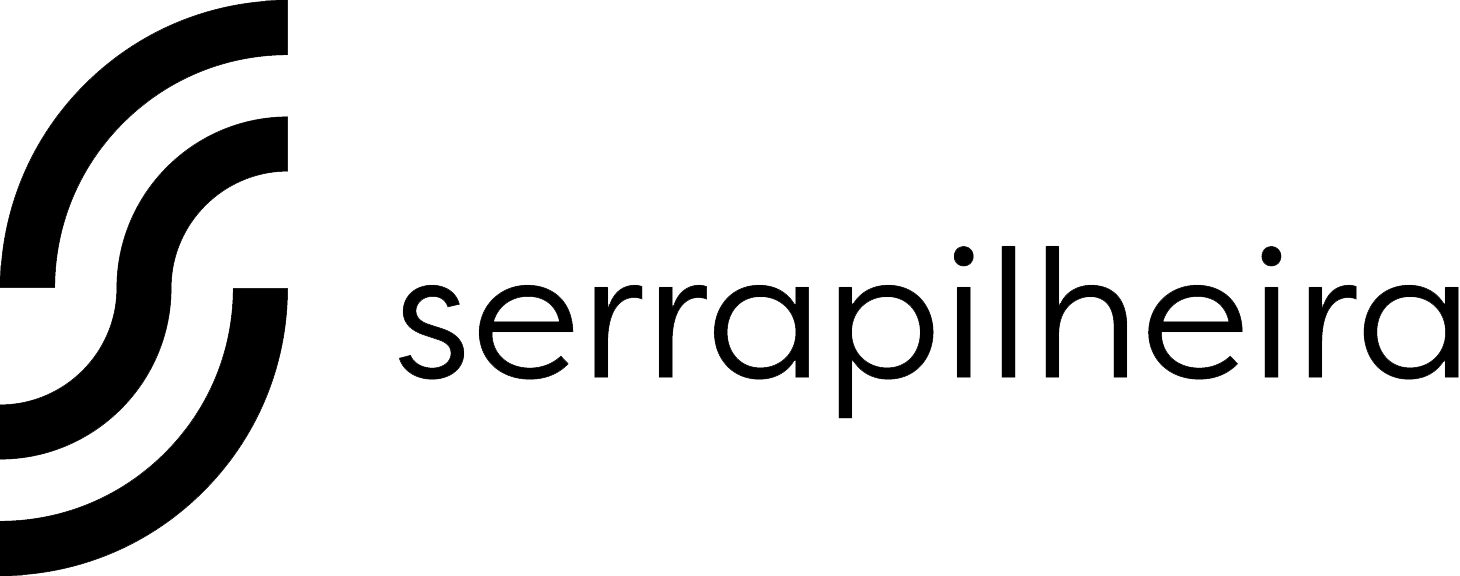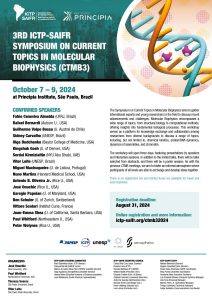3rd ICTP-SAIFR Symposium on Current Topics in Molecular Biophysics (CTMB3)


October 7 – 9, 2024
São Paulo, Brazil
Venue: Instituto Principia
Zoom ID: 835 5924 3231
Password: molecular
Home
The Symposium on Current Topics in Molecular Biophysics aims to gather international experts and young researchers in the field to discuss recent advancements and challenges. Molecular Biophysics encompasses a wide range of topics, from structural biology to computational methods, offering insights into fundamental biological processes. This workshop serves as a platform for knowledge exchange and collaboration among researchers from diverse backgrounds to discuss a range of topics, including, but not limited to, chemical kinetics, protein/RNA dynamics, dynamics of assemblies, and chromatin.
The workshop will span three days, featuring presentations by speakers and interactive sessions. In addition to the invited talks, there will be talks selected from abstracts, and there will be a poster session. As with the previous CTMB meetings, we aim to foster an informal atmosphere where participants of all levels are able to exchange and develop ideas together.
There is no registration fee and limited funds are available for travel and local expenses.
Organizing Committee:
- José Onuchic (Rice University, USA)
- Paul Whitford (Northeastern University, USA)
- Thereza Soares (São Paulo University, Brazil)
- Vitor Leite (São Paulo State University, Brazil)
List of participants: Updated on October 08, 2024.
Announcement:
Registration is now closed.
Speakers
Keynote Speakers:
- Peter Wolynes (Rice University, USA): Protein Dynamics and the Brain
- José Onuchic (Rice University, USA): Modeling the Genome: a View by a Physicist
Invited Speakers:
- Ben Schuler (University of Zurich, Switzerland): Probing the rapid chain dynamics of disordered proteins and nucleic acids
- Kingshuk Gosh (University of Denver, USA): Sequence patterning and charge regulation dictate conformation in IDPs
- Joan-Emma Shea (University of California, Santa Barbara, USA): Self-Assembly of the Tau Protein: Liquid-Liquid Phase Separation and Fibrillization
- Guilherme Volpe Bossa (Southern University of Chile/ Racah Institute of Physics, The Hebrew University of Jerusalem): Optimal antimicrobial response to a changing microbial background at a mucus interface
- Roberto K. Salinas (IQUSP): Uncovering the association mechanism between two intrinsically flexible proteins
- Vitor Leite (Universidade Estadual Paulista, Brazil): Unraveling the Functional Mechanisms of Intrinsically Disordered Proteins Through Energy Landscape Visualization
- Garegin Papoian (University of Maryland, USA): Simulating Life Processes Across Scale
- Serdal Kirmizialtin (NYU Abu Dhabi, UAE): RNA Structural Dynamics Revealed by Experimentally Guided Simulations
- Olga Dudchenko (Baylor College of Medicine, USA): Three-Dimensional Genome Architecture Persists in a 52,000-Year-Old Woolly Mammoth Skin Sample
- Antonio B. Oliveira Jr (Rice University, USA): Modeling Genome Organization from an “Agnostic” Point of View
- Vittore Scolari (Institut Curie, France): A mean-field theory for predicting single polymer collapse induced by neutral crowders
- Amanda Souza Câmara (IPK, Germany): Different ways of compacting holocentric chromosomes
- Shaker Chuck Farah (São Paulo University, Brazil): Bacteria Wars: Structural and functional studies on a bactericidal type IV secretion system
- Rafael Bernardi (Auburn University, USA): Computational Biophysics Approaches to Mechanosensing
- Miguel Machuqueiro (Universidade de Lisboa, Portugal): Constant-pH MD simulations as a tool to unveil the pH effects on biomolecules
- Monica Pickholz (Universidade de Buenos Aires): Exploring the Mechanical Properties of Polymerosomes through Molecular Dynamics Simulations
- Paul Whitford (Northeastern University, USA): Quantifying large-scale dynamics of complex molecular assemblies
Abstracts: Here
Short Talks
- Ander Francisco Pereira (UNICAMP): Exploring the energy landscape for the fold-switching MAD2 protein using Structure-Based Models
- Murilo Sanches (UNESP): Mechanisms and Kinetics of Secondary Nucleation in Amyloid-beta Aggregation
- Mariana Simões Ferreira (Intitute of Biophysics Carlos Chagas Filho): Evaluation of quantum descriptors on Molecular Dynamics Simulations of vivapain-2, a cysteine protease from Plasmodium vivax
- Marcelo D. Polêto (Universidade de São Paulo – EEL – Departamento de Biotecnologia): Optimizing PET biorecycling solutions through electronically polarizable simulations
- Felipe Cardoso Ramos (Institute of Chemistry/UNICAMP): Computational Investigation of Ultrafast Protein-Water Interactions
- Vinicius Contessoto (Rice University): Modeling Structural Ensembles Of Genomes
Abstracts: Here
Short talk format: 10 + 5
Posters
- Aguinaldo Robinson de Souza (São Paulo State University – Department of Chemistry): Theoretical and experimental studies of the interaction between human serum albumin (HSA) and bovine serum albumin (BSA) proteins and molecules of pharmacological interest.
- Ana Luiza Martins Karl (Laboratório Nacional de Computação Científica): Incorporating Receptor Flexibility into DockThor Through Ensemble Docking Technique
- Anderson Aparecido do Espirito Santo (FFCLRP – USP: Departamento de Química): Thermodynamic Optimization of Mimetic Antibodies via Genetic Algorithms: A Molecular Simulation Study
- Axel Mena (Pontificia Universidad Catolica de Chile): Study on optical properties of hydrogel algae base and photosensitizer
- Camila Assis Tavares (Universidade Estadual de Campinas – UNICAMP): From Atomic Details to Viral Biology: The Significance of Light-Material Distribution in Zika Virus Structure
- Dante Arroyo Anhesini (Universidade Estadual Paulista “Júlio de Mesquita Filho”): Critical Adsorption of Polyelectrolytes Onto Heterogeneously Charged Surfaces
- Danilo Kiyoshi Matsubara (Institute of Chemistry – University of São Paulo): De Novo Design of Antiviral Proteins: Targeting the Viral Entry Mechanisms of SARS-CoV-2, Chikungunya, and Dengue
- Evelyn Rayani Dias de Araujo (Universidade Estadual Paulista): Rational Design and Computational Modeling of BPdC Ligands for the N-Terminal Domain of Nucleoprotein of hRSV
- Jéssica de Oliveira Araújo (Universidade Estadual de Campinas): Solvation Effects on the Dimerization Mechanism of Non-structural Protein 9 (NSP9) in Biochemically Relevant Solvents
- Juliana Bueno de Camargo (Instituto de Biociências, Letras e Ciências Exatas): Evaluating the Impact of N-Terminal Acetylation on Antimicrobial Peptides Using ELViM and SuAVE
- Larissa Maria Ferreira Adolfo (UNESP): Investigation of the energetic landscape of amylin and its pathological mutant
- Lidiane Thaís da Silva Abadessa (Universidade Federal do Paraná): SYNTHESIS AND CHARACTERIZATION OF AMINO ACIDS ORGANOMETALLIC COMPLEXES
- Manuel Eduardo Hernandez-Garcia (Mexico Mexico Benemérita Universidad Autónoma de Puebla):
- Marina Lima (ICMC – USP): Mathematical Modelling and Simulations of Successive Waves of COVID-19 in Brazil
- Rafael Giordano Viegas (Instituto de Biociências, Letras e Ciências Exatas (IBILCE/UNESP)/ Instituto Federal de São Paulo (IFSP/Catanduva): Exploring the Folding Landscape of the SAM-II Riboswitch: Crucial Roles of Magnesium Ions and A-Minor Interactions
- Raphael Dias (State University (UNESP) – IBILCE): M2-1 Protein of hMPV and hRSV Viruses – Mechanisms of Conformational Changes and Their Implications
- Ricardo Belarmino de Souza Júnior ( UNESP): The role of charge regulation and charge patch mechanisms on the adsorption of confined cytochrome c
- Sarah Tolentino Rocha Brandão (Instituto de Química da UNESP – Araraquara – IQAr): ELECTROCHEMICAL EVALUATION OF REDOX-TAGGED SELF- ASSEMBLED PEPTIDE FOR POTENTIAL USE AS BIOSENSOR INTERFACE
- Vinicius Firmino dos Santos (Universidade de São Paulo): Coarse-Grained Models of Polymer Brushes with Biotechnological Applications
- Vinicius Piccoli (Institute of Chemistry – CCES – UNICAMP): Solvation of Drugs in Deep Eutectic Solvents via Kirkwood-Buff Theory
- Pamella Cristiny Carneiro da Silva (Institute of Chemistry): Plasmodium falciparum complex systems: Molecular Dynamics of Intrinsically Disordered Proteins in Ionic Liquids
- Isabela Brunozi de Oliveira (Unesp): Ligand-based approach for predicting potential natural inhibitors for SARS-CoV-2 Mpro
Participants MUST BRING THE BANNER PRINTED.
For details about the poster presentation, please look at the Additional Information tab.
Registration
Program
Sessions and Abstracts: HERE
Videos and Files
- 09:30 - Peter Wolynes (Rice University, USA): Protein Dynamics and the Brain
- 11:00 - Ben Schuler (University of Zurich, Switzerland): Probing the rapid chain dynamics of disordered proteins and nucleic acids
- 11:45 - Ander Francisco Pereira (UNICAMP): Exploring the energy landscape for the fold-switching MAD2 protein using Structure-Based Models
- 13:30 - Joan-Emma Shea (University of California, Santa Barbara, USA): Self-Assembly of the Tau Protein: Liquid-Liquid Phase Separation and Fibrillization
- 14:15 - Kingshuk Gosh (University of Denver, USA): Sequence patterning and charge regulation dictate conformation in IDPs
- 15:00 - Murilo Sanches (UNESP): Mechanisms and Kinetics of Secondary Nucleation in Amyloid-beta Aggregation
- 15:15 - Guilherme Volpe Bossa (Southern University of Chile/ Racah Institute of Physics, The Hebrew University of Jerusalem): Optimal antimicrobial response to a changing microbial background at a mucus interface
- 16:30 - Roberto K. Salinas (IQUSP): Uncovering the association mechanism between two intrinsically flexible proteins
- 17:10 - Vitor Leite (Universidade Estadual Paulista, Brazil): Unraveling the Functional Mechanisms of Intrinsically Disordered Proteins Through Energy Landscape Visualization
- 09:00 - Garegin Papoian (University of Maryland, USA): Simulating Life Processes Across Scale
-
09:45 - Serdal Kirmizialtin (NYU Abu Dhabi, UAE):
RNA Structural Dynamics Revealed by Experimentally Guided Simulations
- 11:00 - Olga Dudchenko (Baylor College of Medicine, USA): THREE-DIMENSIONAL GENOME ARCHITECTURE PERSISTS IN A 52,000-YEAR-OLD WOOLLY MAMMOTH SKIN SAMPLE
- 11:30 - Antonio B. Oliveira Jr (Rice University, USA): Modeling Genome Organization from an “Agnostic” Point of View
- 12:00 - Vittore Scolari (Institut Curie, France): A mean-field theory for predicting single polymer collapse induced by neutral crowders
- 14:00 - Amanda Souza Câmara (IPK, Germany): Different ways of compacting holocentric chromosomes
-
14:30 - Mariana Simões Ferreira (Intitute of Biophysics Carlos Chagas Filho):
Evaluation of quantum descriptors on Molecular Dynamics Simulations of vivapain-2, a cysteine protease from Plasmodium vivax
- 14:45 - Marcelo D. Polêto (Universidade de São Paulo – EEL – Departamento de Biotecnologia): Optimizing PET biorecycling solutions through electronically polarizable simulations
- 15:00 - Shaker Chuck Farah (São Paulo University, Brazil): Bacteria Wars: Structural and functional studies on a bactericidal type IV secretion system
- 16:30 - Paul Whitford (Northeastern University, USA): Quantifying large-scale dynamics of complex molecular assemblies
- 09:00 - Rafael Bernardi (Auburn University, USA): Computational Biophysics Approaches to Mechanosensing
- 09:45 - Felipe Cardoso Ramos (Institute of Chemistry/UNICAMP): Computational Investigation of Ultrafast Protein-Water Interactions
- 10:00 - Miguel Machuqueiro (Universidade de Lisboa, Portugal): Constant-pH MD simulations as a tool to unveil the pH effects on biomolecules
-
11:00 - Monica Pickholz (Universidade de Buenos Aires):
Exploring the Mechanical Properties of Polymerosomes through Molecular Dynamics Simulations
-
11:30 - José Onuchic (Rice University, USA):
Modeling the Genome: a View by a Physicist
asdasdasd
Photos
Additional Information
Attention! Some participants in ICTP-SAIFR activities have received email from fake travel agencies asking for credit card information. All communication with participants will be made by ICTP-SAIFR staff using an e-mail “@ictp-saifr.org”. We will not send any mailings about accommodation that require a credit card number or any sort of deposit.
BOARDING PASS: All participants, whose travel has been provided or will be reimbursed by ICTP-SAIFR, should bring the boarding pass upon registration. The return boarding pass (PDF or scanned or photo) should be sent to secretary@ictp-saifr.org by e-mail.
COVID-19: Brazilians and foreigners no longer have to present proof of vaccination before entering the country.
Visa information: Nationals from several countries in Latin America and Europe are exempt from tourist visa. Nationals from Australia, Canada and USA are exempt from tourist visa until April 10, 2025. Please check here which nationals need a tourist visa to enter Brazil.
Accommodation: Participants whose accommodations will be provided by the institute will stay at The Universe Flat. Hotel recommendations are available here.
How to reach the Principia Institute: The meeting will be held in the first-floor auditorium of the Science Center at Principia Institute located at Rua Pamplona, 145 near the Trianon-Masp metro station.
Poster presentation: Participants who are presenting a poster MUST BRING A PRINTED BANNER . The banner size should be at most 1 m (width) x 1,5 m (length). We do not accept A4 or A3 paper. Click here to see what a banner looks like: http://designplast.ind.br/produtos/detalhe/impressao-digital/banner/119/9

